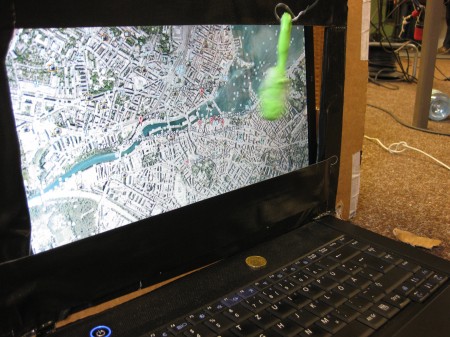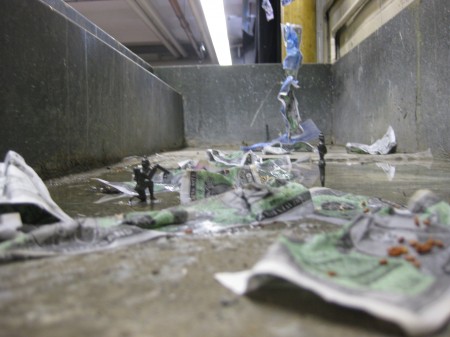Money – It Came From Outer Space! No, this is not a long lost Sun Ra record, it’s the working title of Chris Kondek and Christiane Kühl’s workshop for tt 10’s international forum.
This year, the international forum, which brings together some of the best and brightest theater persons from around the world, focuses on the questions: ‚How can theater deal with the world? And what are the realities created by the art of theater?‘
In their workshop, Kondek and Kühl have developed an interesting way to deal with the world, and with money in particular. They have asked the question: what happens when we talk about money as if it were a foreign creature, as if it weren’t the self-evident means to an end whose presence we take for granted everyday? And, furthermore, what happens if we look at money as we do science fiction films? What happens if we understand money as one of these abominable creatures?
Sounds fascinating, right?
I attended a day of Kondek and Kühl’s workshop and took the following notes.

Behind the Scenes: The Attack of the Flying Blob Money. Photo: Shane Anderson
As I walk into the workshop room, the ten-odd participants are reading aloud an article on hedge funds.
„Hedge funds are not as regulated as real estate funds. Companies, for instance, are not required to report the losses and gains of their hedge funds.“
Wait, really?
Everyone’s a little shocked, confused.
Could this be true? How long have hedge funds been allowed? What function do they serve? Is there any stopping them? And just what are they, exactly?
Feeling the tension, Kondek smiles. He calls everyone over to the other side of the room and puts on a video. We watch as the Blob oozes through ventilation vents in a movie theater and then moves on to destroy a town. Half in jest, Kondek identifies the various market structures and key players (he calls the Blob hedge funds; the town, the market; the unsuspecting public, well, the unsuspecting public), and half in earnest, explains hedge funds.
Watching ‚the Blob,‘ one notes that the police and general public in the film are employing the same language when talking about the Blob as the workshop participants were when they were wondering about hedge funds.
‚Is there any stopping it?‘
‚You have to freeze it.‘
Suddenly, there’s an electricity in the room, a light bulb above head flicker, an understanding.
Suddenly, this overlapping of science fiction and finance doesn’t seem all that out of this world.

Behind the Scenes: Army Men in a Battlefield of Money. Photo: Shane Anderson
Having initiated these ideas, Kondek and Kühl switch over to praxis, showing clips of their work „Übermorgen ist zweifelhaft / 2012.“ Here, Kondek emphasizes the technical aspects of using video on stage, of turning film ideas into stage ideas. But, on closer examination, it seems K+K also want to demonstrate how one can initiate a discussion of ideas and realities that normally lie outside of the expectations of a theater experience. If money is going to be on stage, we normally expect it to have something to do with love. But creating an interesting experience out of seemingly non-interesting material isn’t a problem for Kondek and Kühl. Whether their source material be scientists talking about the end of the world, explanations of the Mayan calendar or playing the stock markets with the viewers‘ entrance fees, Kondek and Kühl have become well-known for creating funny, strange and moving theater experiences out of disparate material.
Similarly, an explanation of money and hedge funds doesn’t normally sound like a very invigorating theater experience. But, with the right tools, with a sense of juxtaposition and imagination, these are more than possible. This, I would say, would seem to be the goal of the workshop; that theater can deal with the world by presenting the world through a different lens.

Behind the Scenes: Alien Money Invades. Photo: Shane Anderson
After this demonstration, the workshop participants split up into groups to work on various ideas. Some are clearly inspired by science fiction, others are concentrating on juxtaposition (like Símon Birgisson, who created a beautiful audio piece made up of construction sounds, financial explanations, and classic sci-fi soundtracks amongst other things), and others are still exploring the possibility of video to then be used on stage. The participants, in other words, are taking things very seriously but bringing their own sensibilities to the workspace.
After a couple of hours of observation, I decide to leave the workshop participants to explore further. They will be showing their work to the other three workshops in a presentation on Sunday and there’s still a lot of work to do. I ask Christiane what they plan on showing and she’s not really prepared to answer. There’s still plenty of time and they all seem to be thriving on the suspense. There’s momentum. And besides, this is not a full-fledged theater evening they’re planning, but an experiment with colleagues to present to other colleagues.
Whether these experiments will then create a reality within ‚the art of theater‘ is still an open question. But, in the meantime, the international forum has forged bonds between artists working all over the world, as well as a workshop where they can explore new ideas and tactics and develop new tools to make theater.
It was a fascinating day, and I’m excited to see what comes of it, not only here in Berlin at the end of the forum, but in the world at large.